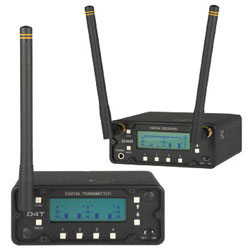|
D4 System
| |
|
| Digital Wireless System
The D4 digital wireless system was designed as a special
purpose system for location production in film and
television.
A typical application for this system is in television
production as part of what is commonly called a "bag
system". A portable mixer and several wireless microphone
receivers are carried in an over-shoulder carrying
case. The D4T transmitter is connected to the outputs of
the mixer to transmit up to four audio channels to one or
more D4R receivers mounted on video cameras.
The system is designed for line level analog audio signals
and AES/EBU digital audio signals with options that
provide:
- Digital in/Digital out
- Digital in/Analog out
- Analog in/Digital out
- Analog in/Analog out
|
The system can be configured to provide either 2 or 4
audio channels. In the 4-channel mode, four different
bands may be selected as shown below. Each frequency
carries four audio channels, digitally multiplexed on a
common carrier. In the 2-channel mode, eight different
frequencies are available as shown below, each with two
audio channels.
Multiple D4 systems can be operated in the same location
to provide up to 16 audio channels.
The audio quality is suitable for any professional application
in film, television and live sound. 48 kHz/24-bit
audio, ruler-flat 20-20000 Hz frequency response, ultralow
distortion and high dynamic range assure excellent
audio quality.
Housings and panels are machined aluminum with electrostatic
powder coated and anodized finishes and laser
etched marking for durability.
The analog and digital input and output modes on the
transmitter and receiver do not have to be identical. For
example, analog signals can be fed into the transmitter
from a mixer or wireless mic receivers, transmitted to
the D4 receiver, which can be configured for four digital
outputs to feed a digital recorder. The digital outputs of
the receiver will always be 48 kHz/24-bit audio, regardless
of the sampling rate of any digital signal fed into the
transmitter.
The rear panels provide AES/EBU digital and balanced
analog audio inputs and outputs, a threaded locking
power jack and a USB port, which is used for firmware
updates. AES/EBU digital inputs and outputs are connected
to the CH1 and CH2 jacks since each connection
provides two audio channels. Analog signals are
connected to all four jacks with one balanced audio
channel per jack.
Overall System
Operating Spectrum: 902 - 928 MHz
Center Frequencies (MHz): 4-channel Mode: 907.776, 912.384, 916.992, 923.904. Four 4-channel systems can operate simultaneously for a total of 16 audio channels.
Center Frequencies (MHz): 2-channel Mode: 906.624, 908.928, 911.232, 913.536, 915.840, 918.144, 922.752, 925.056. Eight 2-channel systems can operate simultaneously for a total of 16 audio channels
Modulation Type: Differential QPSK with Forward Error Correction, spread spectrum
Occupied Bandwidth: 4 MHz (4-channel mode), 2 MHz (2-channel mode)
Audio Sampling: 48 kHz, 24-bit
Latency (overall system): Digital In/Digital Out: Less than 1 mS, Analog In/Analog Out: 2.2 mS, Selectable
Audio Channels: 4 digital / 2 digital, 2 analog / 4 analog
Frequency Response: 20 Hz - 20 kHz, ± 0.5 dB
THD+N: < 0.05% (1 kHz @ -10 dBFS)
Dynamic Range: > 104 dB A-weighted
Adjacent Channel Isolation: > 93 dB
D4T Transmitter
Power output: 200 mW
Audio Input: Simulated transformer balanced inputs, clip level adjustable +0 to +20 dBu (or AES/EBU digital standard)
Power requirements: 9 - 16 VDC
Power consumption: 500 mA
Dimensions: 4 x 4 x 1.5 inches
Weight: 339 grams; 12 ounces
D4R Receiver
Diversity Type: Dual receivers with artifact-free digital combining
Audio Output: Electronically balanced outputs, max. level adjustable –20 to +8 dBu (or AES/EBU digital standard)
Power requirements: 9 - 16 VDC
Power consumption: 250 mA
Dimensions: 4 x 4 x 1.5 inches
Weight: 346 grams; 12.2 ozs.
Specifications subject to change without notice.
| 